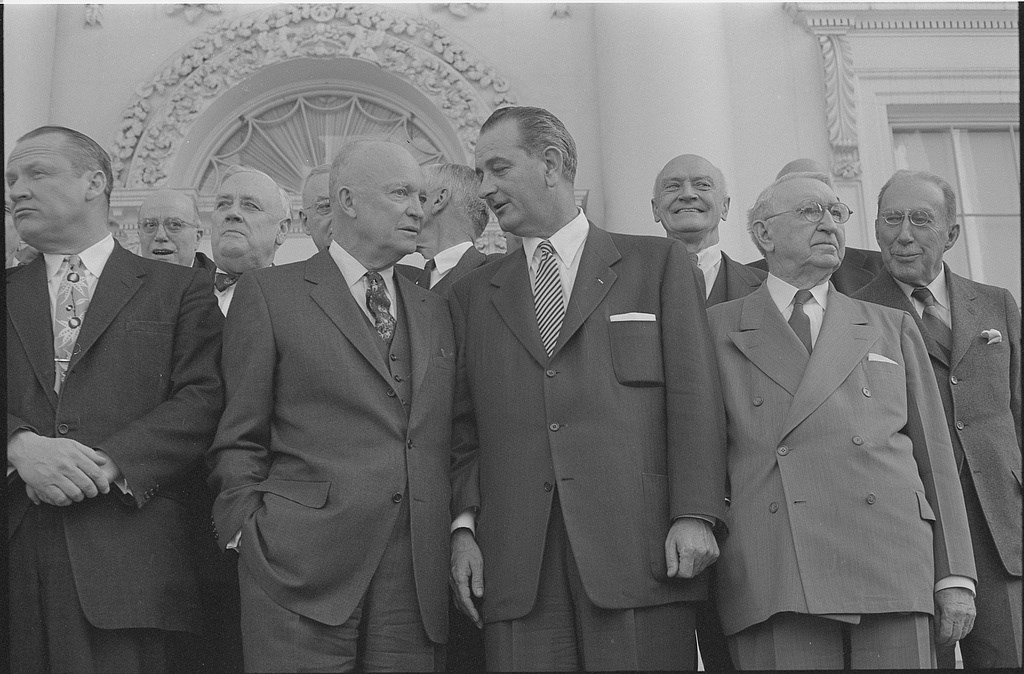Part of a series of articles titled Eisenhower and the Nuclear Arms Race in the 1950s.
Next: “Project Solarium”
Article

Library of Congress
Shortly after the lifting of the Berlin Blockade, in August 1949, the Soviet Union broke the American nuclear monopoly by developing its own atomic bomb. The Soviets had matched the United States’ key technology sooner than most expected. This development forced the United States to reevaluate its defense posture and accelerated the creation of even more powerful weapons, such as the hydrogen bomb, to regain its nuclear superiority. An analysis of the United States’ defense position was presented to President Truman in the National Security Council Paper Number 68 (NSC 68). NSC 68, authored largely by Paul Nitze of the State Department policy staff, would come to shape American policy for many years. NSC 68 outlined that the United States needed to be prepared globally for Soviet or communist expansionism and that containment should become a global policy. The directives outlined in NSC 68 were written prior to the North Korean invasion across the 38th parallel but were not adopted until September 1950, after this conflict proved to many the necessity of American military buildup.
By the early 1950s American foreign policymakers knew that the Cold War was here to stay. Communism seemed everywhere on the move, exemplified by the crises described above and then most dramatically with the North Korean invasion of June 1950 that began the Korean War. Western policymakers believed countries at risk from Communist aggression might fall if their neighbors succumbed, like the rotten apples of Acheson’s metaphor or, more commonly, like so many dominoes: if one country was lost to the Communists, so too would be the next, and the next. Communism had to be stopped, but at what cost? The increasing conflict between the United States and the Soviet Union and the arms race would shape the United States strategic defense program and Intercontinental Ballistic Missile development. In the Cold War, the United States would maintain its stance that the only way to halt the expansion of communism was through development of increasingly advanced weapons systems.
The Cold War and the directives of NSC 68 led to a significant increase in American military spending. Just over $13 billion was spent on the country’s defense in 1950, while only three years later total American defense spending exceeded $50 billion, or nearly forty percent of the federal budget. Much of this increased spending can be attributed to the Korean War; however, many United States policymakers believed that defense spending would continue at this elevated level for the foreseeable future. Their predictions ultimately proved correct, as spending on American forces dipped after the war to approximately $34- $38 billion a year, while military and financial aid delivered to allies in the name of halting communism averaged nearly $12 billion annually throughout the remainder of the decade. This level of Cold War spending became the norm until the height of the costly Vietnam War.
President Dwight D. Eisenhower took office in 1953 with a pledge to lower the cost of waging the Cold War, what he called “waging peace.” He feared a prolonged military conflict and a commensurate expansion of the military and federal government might undermine the country’s democratic values.
President Eisenhower did not dispute NSC 68’s basic principles, in particular its contention that Soviet Communism was inherently expansionistic and thus a threat to the United States, but he feared the effects of a broad Cold War fight on America’s economy and society. Increased military spending could warp the marketplace, while efforts to combat Communism at home, if not carefully regulated, might ultimately undermine American civil liberties. As Eisenhower stated, his administration was charged with defending “a way of life,” not just a territory and “We could lick the whole world if we were willing to adopt the system of Adolph Hitler.”
These were hardly idle concerns. During this same period, Senator Joseph McCarthy led the charge against Communism at home, popularly known as the Red Scare, with largely unsubstantiated accusations that Communists had infiltrated the federal government and the State Department in particular.
McCarthy’s accusations caused a sensation. Following televised Congressional hearings in 1954, where McCarthy accused the Army of harboring Communists, he was censured by the Senate for his actions. The country’s rabid anti-Communist hysteria began to slow, though Cold War fears continued to color American political and cultural life for more than a generation. As Eisenhower had feared, anti-Communism, as espoused by McCarthy and others, was distorting American values.
Part of a series of articles titled Eisenhower and the Nuclear Arms Race in the 1950s.
Next: “Project Solarium”
Last updated: October 20, 2020